
Don't get too excited - the spelt is only 20% of the flour - but it makes for a nice loaf!
It's ages since I've posted details of one of my bakes on TFL. TFL is full of baking questions at the moment, so I thought a few details and pictures of my weekend spelt bake might give a bit of content variation.
It was a pretty simple bake (for me!) with 20% mockmilled spelt, 3% rye from the levain and a hydration of 74%. It includes 1% of my current favourite ingredient, fava bean flour.
I'm running a trial with my starter at the moment, keeping it on the counter and feeding it once a day, rather than keeping it in the fridge. The plan is to see if it has more "vitality" managing it this way.
Flour mix
200g Mockmilled spelt
780g bread flour
10g diastatic malt flour
10g fava bean flour
Levain
Build 1 at e7 day0: 5/25BF-5rye/24water 27C
Build 2 at m8 day1: 55/80-30/88 29C
Other
True hydration 74%
Salt 1.8%
Process
m11 day1: Spelt flour autolysed with 160g RT water + 2g salt
e1 day1: 532g water in mixer, add dry flours and spelt mixture. Autolyse 15min
Add 225g levain, mix in
3min low speed
add 18g salt and mix 2min low speed
Mix on high speed 1min 30secs
Drip in 40g bassinage water on low speed, total time 4min
Turn out of the mixer into proofing bowl, dough temp 25C
Bulk ferment at 25C for 4hrs 15mins with a couple of coil folds. Volume increase about 55%
Preshape to 2 x 850g batards. BR 20mins
Shape, proof on counter for 20mins
Retard in fridge overnight
Score and bake as normal with steam
Thoughts
Good ears and nice blisters.
Pretty open crumb
Mild flavour - I'd like to get a bit more lactic tang in - maybe by reducing levain quantity and fermenting longer?
Photos
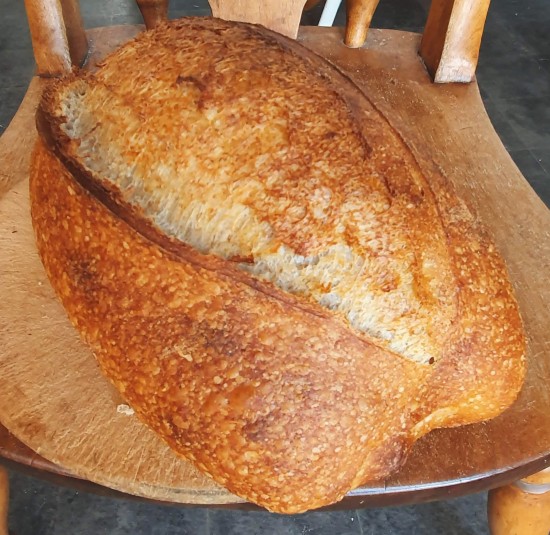
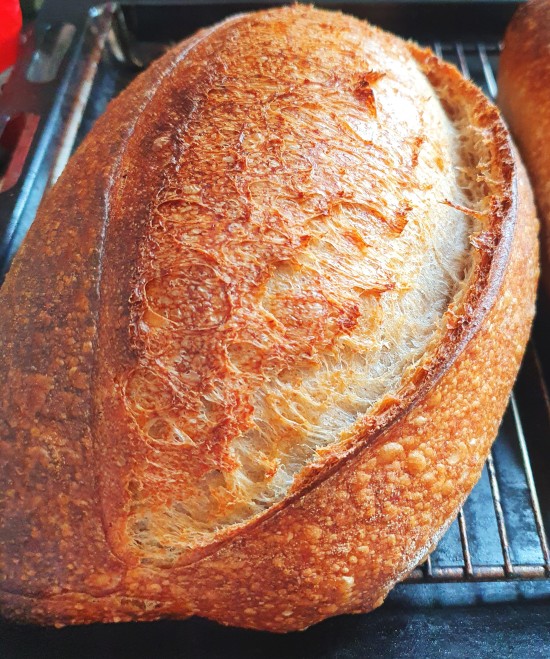
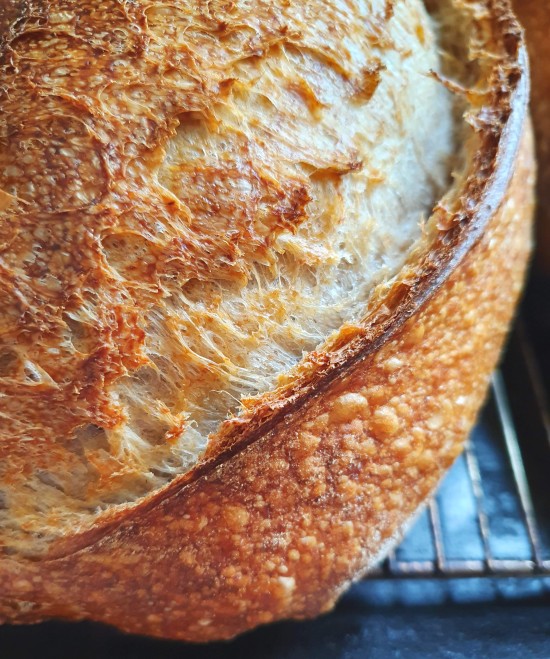
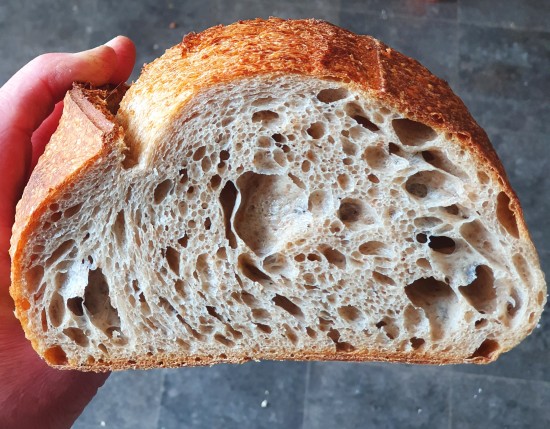
Lance
- albacore's Blog
- Log in or register to post comments
Nice looking loaf, Lance.
How does the DM (1%) affect the fermentation and also the flavor of your bread?
Is your flour malted at the mill?
You wrote, “I'm running a trial with my starter at the moment, keeping it on the counter and feeding it once a day, rather than keeping it in the fridge.”
There is no way (that I know of) to feed my starter on the counter with a 24 hr cycle. I’ve read that others claim the same, but I have no idea how this is done. I imagine it could be retarded at 50F or so. That might work, haven’t tried it yet. I struggle to cycle mine for 12 hr. It requires something like 1:3:5 @ 76F
Thanks Danny
I don't really notice any other effects from it. I suspect that American flour has more malt added to it at the mill. There will be some in UK bread flour, but maybe not as much as you have.
This is working but the starter is lacking lactic sour because of the low temp. Really it would be better to keep it at 25C and feed it twice a day. But I only bake once or twice a week and I'm already finding daily feeds tedious!
The other thing I am looking at is to cold store the starter between uses, but not at 4C fridge temp, rather at 11C, as recommended by Teresa Greenway, and refresh maybe twice a week.
So the current project in progress is a little starter fridge. Think 100x100x100mm cavity, 50mm Polyiso insulation and a peltier module.......
Lance
Lance, if you can find it, please send me the link to Teresa’s writeup on fermenting the starter @ 15C/60F. I’d like to take a look.
No, Teresa doesn't mention that. The article of hers that I read was about storing starters. Reading it again, she recommends 42-50F, but I have seen 52F mentioned elsewhere.
Lance, I’m not sure you saw my retarder. It utilizes a compact upright freezer and a Johnson Controller. It maintains any desired cool to cold temperature with dead on accuracy. I also run a 12 volt computer fan inside the unit to move the air.

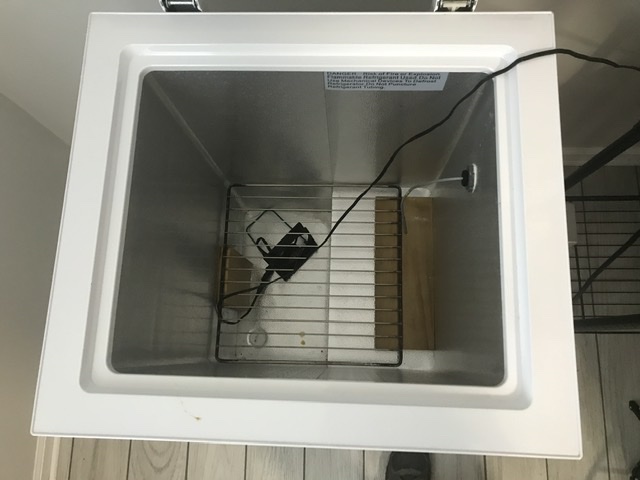
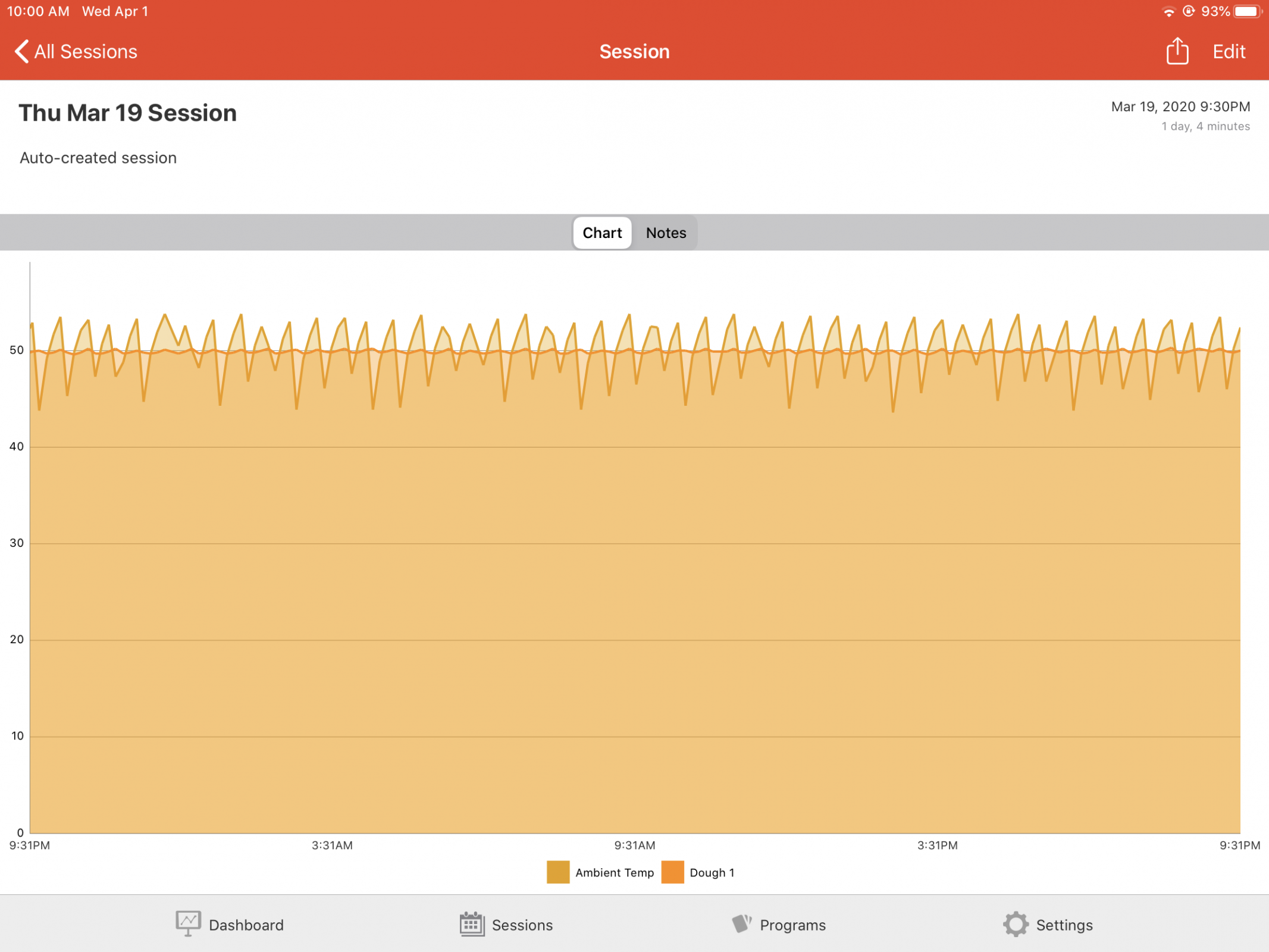
The zig zag line is the unit cycling on and off the stable line is the temperature of a probe placed in a glass of water.
I plan to run my starter at 50F to see how it affects it. Thanks for the post.
Looks good Danny, but I haven't got space for one of those. This is my rather more diminutive version. As I said, it's work in progress....
Lance
How do you control the temperature?
How cold will the Pelletier get?
That baby is super insulated.
I picked up a couple of LAE temperature controllers. Here's one:
I need to fit a probe in the box to link into the controller. It will be a simple on/off control. There are better ways to control peltiers, but they are expensive and not readily available.
My initial trial today was promising - I ended up with frost on the cooling panel inside the box. Though peltiers are notoriously inefficient - the coefficient of performance is about 5 times worse than a standard phase change fridge. That's why it needs all that insulation.
Lance
lance I contacted Teresa about retarding the starter. Here is a collection of her replies. By the way - that is a very old post.
” I've always felt that starters do much better at room temperature and did keep mine that way for years. It's also impractical and uses a lot of flour unless you are a bakery. If I had a place to keep starters above 40F constant temp right now I would do it. I used to have a fridge that I used for that but it is long gone. I pretty much would feed the starter and put it in the dedicated fridge right away. It was above 40 enough so that the starter fermented in a timely fashion. Unless I wanted to use it faster, in which case I would leave it out for a while before retarding it.”
“ At room temp or above 40F”
“ I like to use my cold room/solarium in the winter, early spring, late fall to ferment dough. It's great at over 40 something degrees. However it isn't constant, so adjustments have to be made to the dough or it can over ferment.”
“ If I had a bakery though, I would set up a retarder at around 46-50F for proofing dough and keeping starters.”
“ It's also hard to share formulas when using those temps as you can imagine.”
” Well I used to live in room temps in the 50's. Now I have room temps in the 70's If I had a preference I would keep a starter above 40F and below 50F or around 46F”
“ 44F-46F would be great I think.”
Let us know how you get on with your cooler trial and I will do the same when my mini cooler is up and running.
Lance
I often think about wine (no surprises there) in relation to the malt aspect. Sometimes just a little a bit of residual sugar can elevate what would otherwise be a bone-dry wine.
What is your intention with the use of fava bean flour? Usually bean flours are used as a source of lipoxygenases AFAIK.
Generally speaking higher % of levain would favour a shift towards a more lactic flavour while a lower % would open the door for a more acetic flavour.
With your bakes would you notice less blisters if you didn't retard overnight? I almost never use any retarding at any stage but nothing I do will stop the blisters!
Thanks for sharing,
Michael
Michael, no matter what I do, blisters don’t come easy. It amazes me how some things come so easy for some and are so difficult for others.
most write “the secret” for blisters is a cold retard, then you say “you almost never retard, and yet you can’t stop the blisters.
It seems the possible variations in bread baking are limitless...
Dan
Hey Dan. I do wonder if there is any relationship between microflora and appearance of blisters...
Yes, malt is good stuff to have in your armoury! Of course loaf browning also depends on your oven; I have top and bottom elements, but the distance between the elements is more than in a deck oven, so the top element is further from the bread than I would like.
It's true about a touch of residual sweetness. In sparkling wine there was a fashion recently (maybe still is) for bone dry brut de bruts or brut nature, which mostly taste pretty thin and acidic. Beer also benefits from a spot of PG.
I started to dabble with the fava bean flour after I saw this post on Instagram. For convenience, here is the picture:
The right hand loaf has 4% fava bean flour, 96% Korasan.
Ian Lowe also uses it (in much smaller %age) in his burger buns - just for the crumb whitening effect, I think.
Blisters are a retard thing for me. I think other important factors are the material the banneton is made from and the material the liner (if used) is made from. I don't just mean cotton here, I mean knitted jersey or woven fabric, coarsness of weave, etc.
Lance
Lance, what should I look for when sourcing Fava Beans (Broad Beans)? I know nothing about them but would like to mill some and give them a try.
This is my bag:
These came from a local Asian food store. Think Middle-Eastern food. They are split (hulled). You can buy whole as well. I'm sure they would work too, but I thought better without the skin.
They are big and hard, so I coarsely pre-ground them in a blade coffee grinder before mockmilling. You can buy flour ready ground as well.
Lance
A nice tidy loaf. I use the same ratios for my version which I make often. Did you sift the spelt? What is the most noticeable improvement with the added the fava flour? You guys are making me think I don't have enough gadgets for making bread.
Yes, spelt is tasty. I tend not to go above 20% to avoid the known problems, ie poor gluten, over-extensibility, stickiness. The spelt wasn't sifted for this loaf, but I have sometimes sifted half of it through a #40. I think the fava helps to give a good open crumb. I suspect that I would have had a more closed crumb with 20% unsifted spelt without it.
Gadgets is as gadgets does. I am a scientist by background and like to innovate. I am also blessed with having practical skills and a good set of tools built up over the years, and space in which to use them (though I'd like more!). Breadmaking encompasses all extremes - some are proud to be able to make bread without scales, thermometers or even measures, but that's not me. There is a place for science, art and craft in breadmaking. As my Instagram intro says "Amateur Baker with a belief that science, art and craft can work together to make the perfect loaf" (shameless plug!).
Lance
Lance, I mixed a starter @ 1:2:2 and set it in the retarder at 50F. The starter was not allowed to ferment on the counter before retarding. Each red arrow in the image below represents 12 hours. The starter quite rising after 48 hr. Next time maybe mix 1:5:5 or lower retarder to 46F.
UPDATE - just mixed a 1:(3.5):5 into the proofer at 50F. No counter time. This next test will be more like a typical bread dough (less salt). F results are promising, more testing may be in the works.
Everyone - please share your Pros and Cons for this test. I appreciate input from the outside. “There is wisdom in the multitude of counsel.”
Fava Beans ordered...
Lance I just had a thought.
Suppose we use the levain as an indicator of the BF for the main dough? If we went 1:3.5:5 that would be equivalent to 20% pre-fermented flour @ 70% hydration. 1:8:10 would equate to ~80% hydration at 10% PFF. We could also add 2% salt to be more accurate in our evaluation.
Temperatures could be varied to observe different results.
The main uncontrollable variable would be the dough mass. We know larger doughs ferment faster. But this idea will give us a fairly precise method to determine percentage of rise.
Pros?
Cons?
Contain exponential growth, something I am becoming more familiar with lately. Modeling uncontrollable variables, Projecting outcomes! Seems like life revolves around baking bread and watching the news these days. I will be looking forward to how this one comes out.
"Lance, I mixed a starter @ 1:2:2 and set it in the retarder at 50F. The starter was not allowed to ferment on the counter before retarding. Each red arrow in the image below represents 12 hours. The starter quite rising after 48 hr. Next time maybe mix 1:5:5 or lower retarder to 46F."
Dan, I'm surprised how much activity you're still getting at 50F! I could imagine some initial activity as the temperature stabilises, but yours just carries on. Did you check the temperature in the glass at all?
Lance
No, I didn’t check the temp of the actual starter. But I know for sure the ambient inside the retarder is a constant 50F. I am pretty confident that after the starter normalized (start at ~70F) that the temp was an even 50F throughout.
The latest test (1:(3.5):5 @ 50F) hasn’t moved a bit in the first 12hours. Will continue to monitor on a 12 hour frequency.
It is my hope that from these test results, a bread dough can be completely mixed and placed straight into the retarder in bulk for a known time using a predetermined temp. If successful, the results should produce a very similar rise height. The only real variable that comes to mind is the activity and acidification of the starter at the time of mixing. Any Thoughts?
In the Tartine book Chad recommended that a long bulk fermentation should be between 55 and 65 degrees for slowly getting to "le pointage"
I am beginning to build a keen interest in BF at controllable cool temps. For that, I give thanks to Lance.
It is common practice to use controllable warmth for BF, it may be time to inquire about controllable cool temps for timing and also flavor enhancement. It seems the cool dough may also facilitate more efficient shaping.
The many facets of bread is intriguing...
Impressive bread, I do think you could use 200g of levain and leave it in the fridge longer. But yeah it looks great.
Yes, good point, and reducing levain quantity might give me the touch of lactic sour I am looking for. Fridge times are trickier and always a bit of a leap into the unknown. I often think if I had the time I would go for ambient proof, but then it would be more difficult to score and I would lose the blisters!
Lance
Lance, 25C is perfect for lactic, but the BF will have to run considerably longer. You’re going to think I’m crazy, but reduce the percentage of pre-fermented flour to 2% and try to push the BF out to at least 12 hours. Normally I run that same BF except it runs for 16- 17.5 hours, but I don’t use any whole grains. The dough will definitely eclipse the rise we normally shoot for, but not to worry. Dough degradation is your only concern. The dough will be EXTREMELY extensible at shaping, so forego any autolyse. In this case it is detrimental.
The obstacle you’ll likely run into is dough degradation. I think you can do 12 hours without much gluten damage.
All of the above is targeted to a buildup of Lactic Acid.
Have you experimented with different starters?
No, I just run the one, Pierre-Louis. I find breadmaking can be complicated enough as it is, without maintaining multiple starters!
Lance
Seems like this starter is amazing so I understand. My crust was too thin so I tried a new starter and it all worked out after that. But you never know if it's gonna work out.
"Lance, 25C is perfect for lactic" I might be brave and try this Danny - it would certainly be a leap into the unknown for me! The other route that tempts me is to build levain for a bake and before the final build, split the levain into two. Final build one half at 80%, 26C. - as normal. The other half dilute to 130% and ferment at 32C to boost lactic. A bit like the CLAS process from Rus brot as detailed by Yippee, though I'd have to be careful not to develop that much acid.
Of course I would need two proofing boxes, which I have, but currently Junior hasn't got its own controller, but that's more work in progress!
Lance
A simple way to increase lactic acid levels would be to add some malt syrup into your dough.
Michael, How does malt syrup work to produce lactic acid?
Maltose (malt sugar) is the backbone of lactic acid production. By adding the malt you allow for a ramping up of that production instead of waiting for it to be delivered by enzymes.
Thanks, Michael!
What percentage do you recommend.
what do you think about adding some to the levain? If feasible, what percentage?
It sure is nice to have a few “educated” bakers on the forum. :-)
Danny
I leave the dosage up to you. Perhaps this can be another avenue of experimentation...
It has worked for me but I'd be interested to know your findings.
I am the proud owner of 1 pound of Broad (Fava) Beans.
Should Fava Beans technically be considered a flour?
What is the criteria for flour designation in a bread formula?
Fava flour will absorb moisture like any other flour, so it needs to be allowed for in hydration calculations. It will also add bulk just like any other non-dissolving solid ingredient.
Recipe formulations will often present ingredients that may be difficult to "pigeon-hole", but common sense should prevail. Think about rye grain, for example; it could be whole grain, coarse medium or fine meal (Roggenschrott), or flour. I suspect that given time (overnight?) they will all absorb more or less the same amount of water (possibly the whole grain slightly less). Hence I would include them in with the flour for hydration, pff and salt calculations.
Or are you looking at it from another angle, Danny?
Lance
Yes, I an considering the gluten aspect of flour.
So, should we consider an ingredient a flour in respect to hydration or gluten? Maybe the BBGA or some other such group should be consulted?
Would rice flour be listed as a flour or ingredient in a proper written spreadsheet?
So if you require it to have gluten, then a gluten free formula would always have zero flour in it? Even if it had 500g of sorghum and 500g of oat flour in it?
You make an excellent point. About non-gluten flour(s). So it seems that the flour designation in a Baker’s Percentage spreadsheet is not clearly black and white. Because the other consideration considered was hydration. There are ingredients that are used in bread doughs that are would never be considered flour, but will definitely absorb water and affect the hydration. Examples - powders such as chocolate, cheese, garlic, seeds, etc..
I am comfortable and cozy in a black and white world. But sometimes “you can’t always get what you want”. That boy needs to bake off the drugs...
As I said before Danny, I think a real world, common sense approach wins the day. If you have something like milk powder, for example, it's a no-brainer that it's going to absorb some of your hydrating liquid. Exactly how much might be open to debate, but since the amount added is normally not that large, it's good enough to use the standard recipe hydration.
Similarly, some people say that oils and butters are not part of the hydration, but since they have the same effect I always take them into account as part of "true" hydration.
Lance